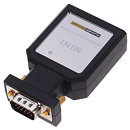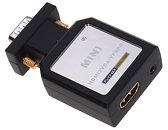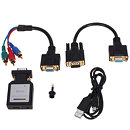- Joined
- Oct 9, 2007
- Messages
- 47,670 (7.43/day)
- Location
- Dublin, Ireland
| System Name | RBMK-1000 |
|---|---|
| Processor | AMD Ryzen 7 5700G |
| Motherboard | Gigabyte B550 AORUS Elite V2 |
| Cooling | DeepCool Gammax L240 V2 |
| Memory | 2x 16GB DDR4-3200 |
| Video Card(s) | Galax RTX 4070 Ti EX |
| Storage | Samsung 990 1TB |
| Display(s) | BenQ 1440p 60 Hz 27-inch |
| Case | Corsair Carbide 100R |
| Audio Device(s) | ASUS SupremeFX S1220A |
| Power Supply | Cooler Master MWE Gold 650W |
| Mouse | ASUS ROG Strix Impact |
| Keyboard | Gamdias Hermes E2 |
| Software | Windows 11 Pro |
If you're feeling the pinch of lack of HDMI inputs on their monitors, you'll find this little dongle from the bi-lanes of Tokyo's Akihabara shopping district handy. The TEC HDCOM-001, as it's called, has a male D-Sub connector on one end, which plugs into the D-Sub connector of your monitor, and an HDMI input. The HDMI connection can carry both video to the monitor and up to 6 channels of audio, which are given out by the dongle as analog audio outputs. The gadget could come handy when pairing Ultrabooks (which lack D-Sub, and provide HDMI) with analog monitors, or those which lack HDMI inputs. It can also be used the other way, to convert D-Sub to HDMI, using an included male to female cable. Its DAC supports display resolutions as high as 1920 x 1080, with 60 Hz refresh rate. Measuring 41 x 72 x 18 mm, it weighs about 120 g. It is priced at 5,480 JPY (US $68).



View at TechPowerUp Main Site



View at TechPowerUp Main Site




